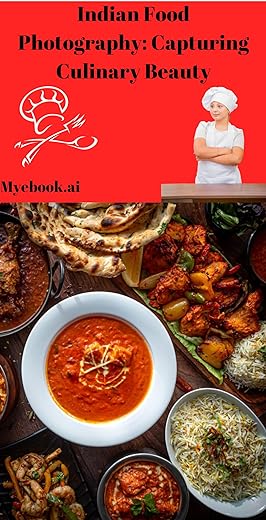Indian Food Photography: Capturing Culinary Beauty
£0.70
Food is an integral part of any culture, and this holds true for Indian cuisine. Each dish is embedded with a rich history, traditions, and stories that deserve to be told through photography. By understanding the cultural significance of Indian dishes, photographers can create images that resonate with a wider audience.
For example, a plate of biryani is not just a sumptuous rice dish; it’s a symbol of Indian hospitality and the fusion of flavors brought by various cultures over centuries. A picture of a thali, with its assortment of curries, bread, and chutneys, tells the story of India’s culinary diversity. A steaming cup of masala chai is more than a beverage; it’s a symbol of comfort and tradition.
Indian food photography, when done with cultural sensitivity, becomes a form of storytelling. It allows viewers to connect with the cuisine on a deeper level, evoking emotions and memories tied to the dishes.
The world of Indian food photography has evolved over the years, driven by changing tastes, the rise of social media, and the global interest in culinary diversity. Social platforms like Instagram and food blogs have given photographers a new canvas to showcase their work and connect with a global audience.
In this digital age, food photography has become an essential part of the culinary experience. It’s not just about showcasing the dish but also the entire dining experience, from the process of cooking to the final presentation. Photographers often collaborate with chefs, restaurants, and food influencers to create engaging content that tells the story of the cuisine.
The popularity of Indian food in the West has also spurred a new interest in Indian food photography. Many Western photographers are now exploring the beauty of Indian dishes, blending traditional and contemporary styles to create stunning visuals.
Indian food photography plays a vital role in preserving and promoting the rich culinary heritage of India. It acts as a bridge between the past and the present, ensuring that traditional recipes and cooking techniques are not lost to time. It also promotes the cuisine on a global stage, attracting a diverse audience eager to savor the flavors of India.
Photographs of Indian dishes not only tempt the taste buds but also inspire people to explore the culture and history behind the food. They encourage home cooks to try their hand at Indian recipes and chefs to experiment with new creations. Indian food photography has the power to ignite a passion for cooking, cultural appreciation, and culinary exploration.
Indian food photography is a mesmerizing journey that captures the soul of a cuisine known for its depth of flavor, cultural diversity, and rich history. With the right blend of technical expertise, artistic vision, and cultural sensitivity, photographers can freeze in time the culinary beauty of India, preserving it for generations to come. As the world continues to celebrate the rich tapestry of Indian cuisine, the lens of the camera remains a powerful tool in sharing this culinary art with the world, one image at a time.
For example, a plate of biryani is not just a sumptuous rice dish; it’s a symbol of Indian hospitality and the fusion of flavors brought by various cultures over centuries. A picture of a thali, with its assortment of curries, bread, and chutneys, tells the story of India’s culinary diversity. A steaming cup of masala chai is more than a beverage; it’s a symbol of comfort and tradition.
Indian food photography, when done with cultural sensitivity, becomes a form of storytelling. It allows viewers to connect with the cuisine on a deeper level, evoking emotions and memories tied to the dishes.
The world of Indian food photography has evolved over the years, driven by changing tastes, the rise of social media, and the global interest in culinary diversity. Social platforms like Instagram and food blogs have given photographers a new canvas to showcase their work and connect with a global audience.
In this digital age, food photography has become an essential part of the culinary experience. It’s not just about showcasing the dish but also the entire dining experience, from the process of cooking to the final presentation. Photographers often collaborate with chefs, restaurants, and food influencers to create engaging content that tells the story of the cuisine.
The popularity of Indian food in the West has also spurred a new interest in Indian food photography. Many Western photographers are now exploring the beauty of Indian dishes, blending traditional and contemporary styles to create stunning visuals.
Indian food photography plays a vital role in preserving and promoting the rich culinary heritage of India. It acts as a bridge between the past and the present, ensuring that traditional recipes and cooking techniques are not lost to time. It also promotes the cuisine on a global stage, attracting a diverse audience eager to savor the flavors of India.
Photographs of Indian dishes not only tempt the taste buds but also inspire people to explore the culture and history behind the food. They encourage home cooks to try their hand at Indian recipes and chefs to experiment with new creations. Indian food photography has the power to ignite a passion for cooking, cultural appreciation, and culinary exploration.
Indian food photography is a mesmerizing journey that captures the soul of a cuisine known for its depth of flavor, cultural diversity, and rich history. With the right blend of technical expertise, artistic vision, and cultural sensitivity, photographers can freeze in time the culinary beauty of India, preserving it for generations to come. As the world continues to celebrate the rich tapestry of Indian cuisine, the lens of the camera remains a powerful tool in sharing this culinary art with the world, one image at a time.
Read more
Additional information
| Publisher | Pon Ajay Varma (5 Nov. 2023) |
|---|---|
| Language | English |
| File size | 657 KB |
| Text-to-Speech | Enabled |
| Screen Reader | Supported |
| Enhanced typesetting | Enabled |
| X-Ray | Not Enabled |
| Word Wise | Enabled |
| Sticky notes | On Kindle Scribe |
| Print length | 130 pages |










Reviews
There are no reviews yet.